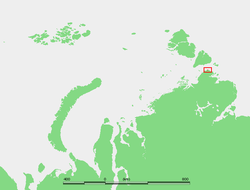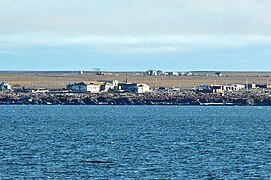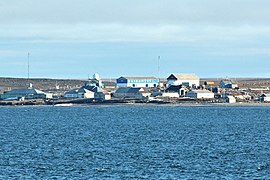geo.wikisort.org - Coast
Cape Chelyuskin (Russian: Мыс Челюскина, Mys Chelyuskina) is the northernmost point of the Afro-Eurasian continent (and indeed of any continental mainland), and the northernmost point of mainland Russia. It is situated at the tip of the Taymyr Peninsula, south of Severnaya Zemlya archipelago, in Krasnoyarsk Krai, Russia. The headland has a 17-metre-high (56 ft) light on a framework tower.[1]
Cape Chelyuskin
мыс Челюскина | |
|---|---|
 Location of Cape Chelyuskin at the northern end of the Taymyr Peninsula | |
 Cape Chelyuskin | |
| Coordinates: 77°44′0″N 104°15′0″E | |
| Location | Krasnoyarsk Krai, |
| Offshore water bodies | Kara Sea Laptev Sea |
Cape Chelyuskin is 1,370 kilometres (850 mi) from the North Pole. Cape Vega is a headland located a little to the west of Cape Chelyuskin. Oscar Bay lies between both capes.[2]
History
The cape was first reached in May 1742 by an expedition on land party led by Semion Chelyuskin, and was initially called Cape East-Northern. It was renamed in honour of Chelyuskin by the Russian Geographical Society in 1842, on the 100th anniversary of the discovery.
It was passed on August 18, 1878 by Adolf Erik Nordenskiöld during the first sea voyage through the North-East Passage.
In 1919 Norwegian explorer Roald Amundsen's ship Maud left behind two men, Peter Tessem and Paul Knutsen, at Cape Chelyuskin after having made winter quarters there. The Maud continued eastwards into the Laptev Sea and the men were instructed to wait for the freeze-up of the Kara Sea and then sledge southwestwards towards Dikson carrying Amundsen's mail. However, these two men disappeared mysteriously. In 1922 Nikifor Begichev led a Soviet expedition in search for Peter Tessem and Paul Knutsen on request of the government of Norway, but Begichev was not successful. Clues to their fate were not found until 1922.
A weather and a hydrology research base named "Polar Station Cape Chelyuskin" was constructed in 1932, and headed by Ivan Papanin. It was renamed the "E. K. Fyodorov Hydrometeorological Observatory" in 1983. The station has a magnetic observatory and stands on the eastern side of the point.
Systematic geological survey for uranium began here in 1946-47 with industrial extraction between 1950 and 1952 in a mountain 150 km south of the cape proper.[3]
The cape hosts the northernmost airfield in Afro-Eurasia, in operation at various locations since 1950.
Climate
Cape Chelyuskin has a tundra climate (Köppen climate classification ET), with no month having a low above freezing. Winters last year round, but may be broken up during the meteorological summer months by short spells of above average temperatures. Snowfall is usual year round, with every year experiencing snow during every month including summer. Sunshine hours peak during April, and begin to sharply drop off during the end of July or early August.
| Climate data for Cape Chelyuskin | |||||||||||||
|---|---|---|---|---|---|---|---|---|---|---|---|---|---|
| Month | Jan | Feb | Mar | Apr | May | Jun | Jul | Aug | Sep | Oct | Nov | Dec | Year |
| Record high °C (°F) | 0.3 (32.5) |
−0.5 (31.1) |
−0.4 (31.3) |
4.3 (39.7) |
8.2 (46.8) |
15.6 (60.1) |
23.3 (73.9) |
21.6 (70.9) |
13.4 (56.1) |
5.4 (41.7) |
−0.3 (31.5) |
−0.6 (30.9) |
23.3 (73.9) |
| Average high °C (°F) | −25 (−13) |
−25.3 (−13.5) |
−23.5 (−10.3) |
−17.1 (1.2) |
−7.5 (18.5) |
0.3 (32.5) |
3.5 (38.3) |
3.0 (37.4) |
−0.8 (30.6) |
−8.9 (16.0) |
−17.6 (0.3) |
−22.7 (−8.9) |
−11.8 (10.8) |
| Daily mean °C (°F) | −28.2 (−18.8) |
−28.4 (−19.1) |
−27.0 (−16.6) |
−20.5 (−4.9) |
−9.9 (14.2) |
−1.3 (29.7) |
1.4 (34.5) |
0.9 (33.6) |
−2.6 (27.3) |
−11.4 (11.5) |
−20.7 (−5.3) |
−25.8 (−14.4) |
−14.5 (6.0) |
| Average low °C (°F) | −31.6 (−24.9) |
−31.6 (−24.9) |
−30.2 (−22.4) |
−23.6 (−10.5) |
−12.3 (9.9) |
−2.8 (27.0) |
−0.1 (31.8) |
−0.5 (31.1) |
−4.4 (24.1) |
−14.4 (6.1) |
−24 (−11) |
−28.9 (−20.0) |
−17.0 (1.4) |
| Record low °C (°F) | −48.8 (−55.8) |
−45.8 (−50.4) |
−45.9 (−50.6) |
−41.7 (−43.1) |
−28.9 (−20.0) |
−18.0 (−0.4) |
−5.7 (21.7) |
−11.2 (11.8) |
−21.2 (−6.2) |
−33.6 (−28.5) |
−41.9 (−43.4) |
−45.6 (−50.1) |
−48.8 (−55.8) |
| Average precipitation mm (inches) | 14 (0.6) |
13 (0.5) |
13 (0.5) |
12 (0.5) |
14 (0.6) |
14 (0.6) |
26 (1.0) |
30 (1.2) |
23 (0.9) |
22 (0.9) |
12 (0.5) |
12 (0.5) |
205 (8.3) |
| Average rainy days | 0 | 0 | 0 | 0 | 0.4 | 6 | 13 | 13 | 6 | 0.6 | 0 | 0 | 38 |
| Average snowy days | 16 | 15 | 15 | 15 | 22 | 11 | 4 | 6 | 16 | 24 | 21 | 17 | 183 |
| Average relative humidity (%) | 83 | 83 | 82 | 83 | 86 | 90 | 93 | 94 | 91 | 86 | 84 | 83 | 86 |
| Mean monthly sunshine hours | 0.0 | 4.0 | 113.0 | 252.0 | 216.0 | 145.0 | 161.0 | 95.0 | 43.0 | 15.0 | 0.0 | 0.0 | 1,044 |
| Source 1: pogoda.ru.net[4] | |||||||||||||
| Source 2: NOAA (sun only, 1961-1990)[5] | |||||||||||||
Photo gallery
- Cape Chelyuskin, northernmost point of Russian and of Eurasian mainland; 77°43’22’’N, 104°15’13’’E
- Polar station at Cape Chelyuskin
- Polar station at Cape Chelyuskin
- Polar station at Cape Chelyuskin
- Polar station at Cape Chelyuskin
- Polar station at Cape Chelyuskin
See also
- List of research stations in the Arctic
- List of northernmost items
References
- Russian Coastal explorer[permanent dead link]
- GoogleEarth
- С.Ларьков, Ф.Романенко. Самый северный остров Архипелага ГУЛАГ Archived August 27, 2010, at the Wayback Machine (in Russian)
- —Погода и Климат. Retrieved 17 November 2012.
- "Cape Celjuskin/Fedo Climate Normals 1961-1990". National Oceanic and Atmospheric Administration. Retrieved January 18, 2012.
Further reading
- William Barr, The Last Journey of Peter Tessem and Paul Knutsen, 1919.
External links
- 17th Century Cape Exploration note
- Russian-Soviet polar stations and their role in the Arctic Seas exploration
- North Pole Drifting Stations (1930s-1980s)
На других языках
[de] Kap Tscheljuskin
Das Kap Tscheljuskin (russisch Мыс Челюскин) ist der nördlichste Punkt der Taimyr-Halbinsel und somit die nördlichste Festlandstelle der Erde. Es ist nach dem russischen Polarforscher Semjon Iwanowitsch Tscheljuskin benannt.- [en] Cape Chelyuskin
[es] Cabo Cheliuskin
El cabo Cheliuskin (en ruso: мыс Челюскина) es un cabo del ártico siberiano que es el punto más al norte del continente euroasiático, y al mismo tiempo es el punto continental habitado más al norte del planeta. Localizado a 1370 km del Polo Norte, se encuentra en el extremo de la península de Taimyr, al sur del archipiélago de Severnaya Zemlya. Está bañado por las aguas del estrecho de Vilkitsky, un estrecho que separa el mar de Kara del mar de Láptev.[ru] Челюскин (мыс)
Челю́скин (мыс Восточно-Северный, мыс Челюскина) — северная оконечность (мыс) одноимённого полуострова, расположенного на севере полуострова Таймыр, и самая северная материковая точка Евразии, Азии и России, а также самая северная точка континентальной суши.Другой контент может иметь иную лицензию. Перед использованием материалов сайта WikiSort.org внимательно изучите правила лицензирования конкретных элементов наполнения сайта.
WikiSort.org - проект по пересортировке и дополнению контента Википедии





